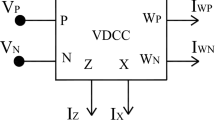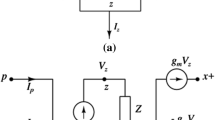Abstract
This article presents the design for a basic current-mode building block for analogue signal processing, named as Current Controlled Current Differencing Transconductance Amplifier (CCCDTA). Its parasitic resistances at two current input ports can be controlled by an input bias current. As it can be applied in current-mode of all terminals, it is very suitable to use in a current-mode signal processing, which is continually more popular than a voltage one. The proposed element is realized in a bipolar technology and its performance is examined through PSPICE simulations. They display usability of the new active element, where the maximum bandwidth is 65 MHz. The CCCDTA performs low-power consumption and tuning over a wide current range. In addition, some examples as a current-mode universal biquad filter, a current-mode multiplier/divider and floating inductance simulator are included. They occupy only single CCCDTA.


























Similar content being viewed by others
References
Toumazou, C., Lidgey, F. J., & Haigh, D. G. (1990). Analogue IC design: The current-mode approach. London: Peter Peregrinus.
Bhaskar, D. R., Sharma, V. K., Monis, M., & Rizvi, S. M. I. (1999). New current-mode universal biquad filter. Microelectronics Journal, 30(9), 837–839.
Pennisi, S. (2002). A low-voltage design approach for class AB current-mode circuits. In IEEE transactions on circuits and systems II: Analog and digital signal processing, Vol. 49, 4 ed., pp. 273–279.
Palmisano, G., & Pennisi, S. (2000). Dynamic biasing for true low-voltage CMOS class AB current-mode circuits. In IEEE transactions on circuits and systems II: Analog and digital signal processing, Vol. 47, 12 ed., pp. 1569–1575.
Ramirez-Angulo, J., Ducoudray-Acevedo, G., Carvajal, R. G., & Lopez-Martin, A. (2005). Low-voltage high-performance voltage-mode and current-mode WTA circuits based on flipped voltage followers. In IEEE transactions on circuits and systems II: Analog and digital signal processing, Vol. 52, 7 ed., pp. 420–423.
Tu, S.-H., Chang, C.-M., Ross, J. N., & Swamy, M. N. S. (2007). Analytical synthesis of current-mode high-order single-ended-input OTA and equal-capacitor elliptic filter structures with the minimum number of components. In IEEE Transactions on circuits and systems I: Fundamental theory and applications, Vol. 54, 10 ed., pp. 2195–2210.
Minaei, S., Sayin, O. K., & Kuntman, H. (2006). A new CMOS electronically tunable current conveyor and its application to current-mode filters. In IEEE Transactions on circuits and systems I: Fundamental theory and applications, Vol. 53, 7 ed., pp. 1448–1457.
Abuelma’atti, M. T., & Al-Zaher, H. A. (1999). Current-mode sinusoidal oscillators using single FTFN. In IEEE trans. circuits and systems-II: Analog and digital signal processing, Vol. 46, pp. 69–74.
Yuce, E. (2008). Design of a simple current-mode multiplier topology using a single CCCII+. In IEEE transactions on instrumentation and measurement, Vol. 57, 3 ed., pp. 631–637.
Khan, A., Abouel-ela, M., & Al-turaigi, M. A. (1995). Current-mode precision rectification. International Journal of Electronics, 79, 853–859.
Dejhan, K., & Netbut, C. (2007). New simple square-rooting circuits based on translinear current conveyors. International Journal of Electronics, 94, 707–723.
DiClemente, D., & Yuan, F. (2007). Current-mode phase-locked loops- a new architecture. In IEEE transactions on circuits and systems II: Express briefs, analog and digital signal processing, Vol. 54, 4 ed., pp. 303–307.
Biolek, D. (2003). CDTA: Building block for current-mode analog signal processing. In Proceedings of the European conference on circuit theory and design 2003—ECCTD’03 (pp. 397–400), Krakow, Poland.
Biolek, D., & Biolkova, V. (2003). Universal biquads using CDTA elements for cascade filter design. In Proceedings of 13th international multiconference CSCC2003 (pp. 8–12), Corfu, Greece.
Acar, C., & Özoguz, S. (1999). A versatile building block: current differencing buffered amplifier suitable for analog signal processing filters. Microelectronics Journal, 30(2), 157–160.
Keskin, A. Ü., Dalibor, B., Hancioglu, E., & Biolková, V. (2006). Current-mode KHN filter employing current differencing transconductance amplifiers. AEU: International Journal of Electronics and Communications, 60(6), 443–446.
Fabre, A. (1983). “Dual translinear voltage/current convertor”, Electron. Letters. vol, 19, 1030–1031.
Grebene, A. (1984). Bipolar and MOS analog integrated circuit design. New York: John Wiley.
Frey, D. R. (1993). Log-domain filtering: an approach to current-mode filtering. IEE Proceedings Circuits, Devices and Systems, 140(6), 406–416.
Ibrahim, M. A., Minaei, S., & Kuntman, H. A. (2005). A 22.5 MHz current-mode KHN-biquad using differential voltage current conveyor and grounded passive elements. AEU: International Journal of Electronics and Communications, 59(5), 311–318.
Hou, C. L., Huang, C. C., Lan, Y. S., Shaw, J. J., & Chang, C. M. (1999). Current-mode and voltage-mode universal biquads using a single current-feedback amplifier. International Journal of Electronics, 86(8), 929–932.
Kaewdang, K., Fongsamut, C., & Surakampontorn, W. (2003). A wide-band current-mode OTA-based analog multiplier-divider. In Proceedings of IEEE International Symposium on Circuits and Systems (ISCAS’03) (pp. I349–I352), Bangkok, Thailand.
Wilamowski, B. M. (1998). VLSI analog multiplier/divider circuit. In Proceedings of the IEEE International Symposium on Industrial Electronics, Vol. 2, pp. 493–496.
Pena-Finol, J. S., & Connelly, J. A. (2001). Novel lossless floating immittance simulator employing only two FTFNs. Analog Integrated Circuits and Signal Processing, 29(3), 233–235.
Khan, I. A., & Zaidi, M. H. (2003). A novel ideal floating inductor using translinear conveyors. Active and Passive Electronic Components, 26(2), 87–89.
Kuntmana, H., Gulsoyb, M., & Cicekoglub, O. (2000). Actively simulated grounded lossy inductors using third generation current conveyors. Microelectronics Journal, 31(4), 245–250.
Pal, K. (2004). Floating inductance and FDNR using positive polarity current conveyors. Active and Passive Electronic Components, 27(2), 81–83.
Yuce, E., Minaei, S., & Cicekoglu, O. (2005). A novel grounded inductor realization using a minimum number of active and passive components. ETRI Journal, 27(4), 427–432.
Çam, U., Kaçar, F., Cicekoglu, O., Kuntman, H., & Kuntman, A. (2003). Novel grounded parallel immittance simulator topologies employing single OTRA. AEU: International Journal of Electronics and Communications, 57(4), 287–290.
Minaei, M., Yuce, E., & Cicekoglu, O. (2006). Lossless active floating inductance simulator. In Proceedings of DELTA’06 (pp. 332–335), Malaysia.
Gulsoy, M., & Çcekolu, O. (2005). Lossless and lossy synthetic inductors employing single current differencing buffered amplifier. In IEICE Transactions on communications, Vol. E88-B, 5 ed., pp. 2152–2155.
Acknowledgments
This work is funded by Graduate College King Mongkut’s University of Technology North Bangkok. The authors would like to thank the anonymous reviewers for their helpful comments.
Author information
Authors and Affiliations
Corresponding author
Appendices
Appendix A
From routine analysis the circuit in Fig. 3, the output current I z can be given by
where
and
We can form Eq. 39 as
where
and \( \varepsilon = \frac{{I_{\text{B}} }}{{g_{\pi 4} \beta_{4} }}\left( {g_{m6} K_{1} + K_{4} + g_{m20} K_{2} - K_{6} - g_{m5} K_{3} } \right) - \frac{{I_{\text{B}} }}{{g_{\pi 1} \beta_{1} }}\left( {g_{m3} K_{1} + K_{5} + g_{m21} K_{2} - K_{7} - g_{m2} K_{3} } \right). \)
If transistors are matched, which are g m10 = g m11, g m1 = g m2 = g m3 = g m4 = g m6 = g m20 = g m21, g m12 = g m13, g m16 = g m17 and g m18 = g m19. The current at Z-terminal can be expressed as
Equation 41 confirms that the circuit in Fig. 3 can function as a current differencing circuit.
Appendix B
Straightforwardly analyzing the circuit in Fig. 4, the current output can be obtained as
where A = g m22 + g π22 + g m23 + g π23 and B = g m24 + g π24 + g π25. We can form Eq. 42 as
where
and
If transistors are matched, which are g m24 = g m25 and g m22 = g m23 = g m . The output current can be expressed as
Rights and permissions
About this article
Cite this article
Siripruchyanun, M., Jaikla, W. Current-controlled current differencing transconductance amplifier and applications in continuous-time signal processing circuits. Analog Integr Circ Sig Process 61, 247–257 (2009). https://doi.org/10.1007/s10470-009-9313-y
Received:
Revised:
Accepted:
Published:
Issue Date:
DOI: https://doi.org/10.1007/s10470-009-9313-y




